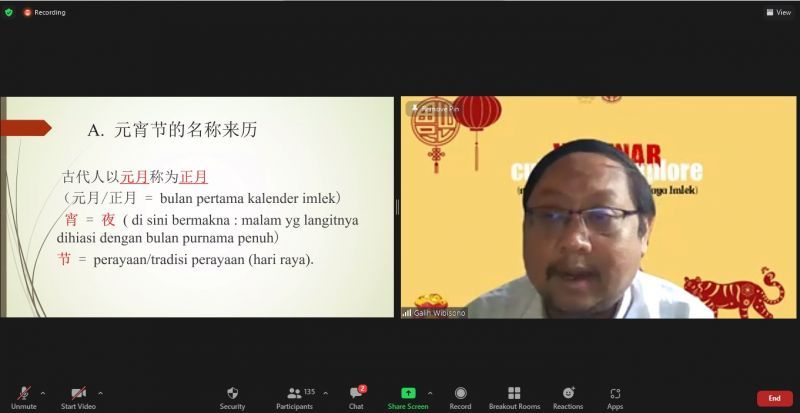
www.unesa.ac.id
Unesa.ac.id, SURABAYA - The UNESA Mandarin Language and Literature Department Student Association is holding a Culture Search Webinar on February 26, 2022. The goal is to explore and introduce millennials to various aspects of Chinese New Year celebrations both in China and in Indonesia.
On that occasion, Galih Wibisono, B.A., M.Ed., UNESA Mandarin Lecturer gave his views regarding Chinese New Year celebrations. According to him, Chinese New Year has a historical side that is still being debated until now. There are some groups that say that Chinese New Year has no history and others think that Chinese New Year still has history.
“Chinese New Year has its own meaning, which is a tradition that is held on a night full of full light. This holiday is usually held in the first month on the 15th night according to the Lunar calendar," he explained.
The birth of Chinese New Year, he continued, was strongly suspected as a result of the influence of Buddhism adopted by the Emperor of the Eastern Han Dynasty in the second century AD who ordered the lighting of the royal lanterns on the 15th night of the first month of the Chinese calendar.
In addition, there is also another theory that explains that Chinese New Year was held to commemorate the tragedy of the Heavenly Emperor who wanted to punish the Chinese people for killing the heavenly bird. “The Chinese New Year celebration is colored with various dances, there are special Chinese New Year performances, as well as various special foods. In fact, there are many culinary delights in Indonesia that absorb Chinese culture," he said.
Rendy Aditya, B.TCFL., M.Pd., Lecturer in Mandarin at the State University of Jakarta, explained that there are several characteristics of Chinese New Year that are quite unique in China, namely, firstly, it is forbidden to clean the house on Chinese New Year because it is considered to throw away luck. However, it is permissible to clean the house on the day before the celebration in order to get rid of evil.
Second, decorating all house ornaments with red, because red is believed to be a symbol of good luck. Third, the typical Chinese food which consists of 12 kinds by referring to the philosophy of the 12 Shio. Fourth, abstain from eating porridge because it is considered a symbol of poverty.
Fifth, lighting fireworks and lanterns as a symbol of readiness to welcome good things throughout the year. Sixth, holding a lion dance performance. Seventh, there is sharing of red packets and Chinese New Year hampers. Eighth, pray in places of worship. Ninth, visiting relatives. "This characteristic is not too much different from the Chinese New Year celebrations in the country," he explained. [UNESA PR]
Author: Saputra
Editor: @zam*
photo: Doc. Committee
Share It On:






